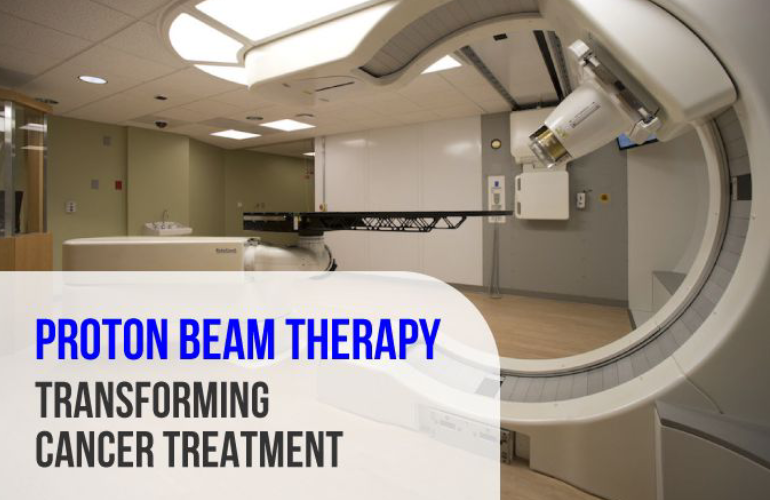What is proton beam therapy?
Routinely external beam radiation treatment uses X-rays for cancer treatment. Proton beam therapy is a form of radiation treatment for cancer that uses protons to kill cancer cells. In this new technology, positively charged particles at high energy can deliver radiation painlessly from a machine outside the body.

Doctors may prescribe proton therapy alone or in combination with other modalities of treatment like X-ray radiation, chemotherapy, surgery, and (or) immunotherapy. Recently, Apollo Hospitals, Chennai commissioned the first Proton Beam Centre in south east Asia, making it one of the few nations with this facility. Read further to know more about proton beam therapy and how it can be benefit you in your cancer treatment.
How is it carried out and how is it different from regular radiation therapy?
A machine called cyclotron accelerates the protons to very high speeds and these positively charged particles achieve high kinetic energy on account of their speed inside the cyclotron. Once they achieve certain level of speed and energy, they are targeted to the tumor at the required dosage.
Like routine radiation, people receive this modality of treatment in an outpatient consultation wherein they can walk-in and get the treatment without a need to get admitted in a hospital. Also like routine radiotherapy, Proton treatment is delivered in multiple fractions or sessions on a daily basis. The number of treatment sessions depends on the stage and the type of cancer. Radiation Oncologists perform Proton based radiation treatments in up to 40 sessions which includes hypofractionated treatment also called stereotactic body radiotherapy (up to 5 sessions) and conventional fraction sessions. If a person receives a single, large dose of radiation, it is often called radiosurgery.
Proton therapy is unique in the manner in which it kills tumour cells. By their physical properties the Protons have been found to deposit the majority of their energy at the point they stop at high speeds. This ensures that the intervening healthy tissues are not exposed to high energy radiation and hence Proton therapy generates less radiation to cells outside the tumor unlike X-ray radiation where the energy gets deposited more along the intervening tissues. Also since protons deposit all their energy at the intended point in tumour there is no radiation going beyond the tumour which happens with X ray radiation where again it is harmful to healthy tissues in the body. This reduces the side-effects of radiation, keeping surrounding tissues undamaged and intact.
When is it prescribed?
Proton treatments are typically prescribed in childhood patients and tumours in critical areas where x-ray radiation can cause severe damage to healthy tissues. Excessive exposure to radiation can lead to long term complications and growth defects in children and hence we exercise caution in using x-ray based radiotherapy while Protons are very useful in pediatric patients due to their safety profile.
Proton treatment requires personalized planning. Prior to treatment, the patient will have a computer tomography (CT) or magnetic resonance imaging (MRI) check. During this scan, they will be in the same position as during treatment.
Movement ought to be constrained while having the scan. So the patient might be fitted with a device/mask that makes them remain still. The sort of device relies upon where the tumor is in the body. For instance, an individual may need to wear a special mask for a tumor in the eye, or head.
During the radiation planning scan, the patient rests on a table and the specialist examines the spots on the body where the radiation treatment should be delivered. The patient is then made to lie in treatment position and a thermoplastic mask or other devices may be snuggly placed over the desired area to ensure immobility during treatment. This helps ensure precision during every proton treatment.
The devices are intended to fit cozily so there is no movement. However, the patient should be comfortable during treatment. The radiation oncologist uses the radiation treatment scan to stamp out where the tumors are on the body. A planning scan is carried out with the mask/devices in place to demarcate the tumour and healthy tissues on a computer software which is then run to plan the treatment with given doses. This procedure is like the radiation planning process with X-rays. Once a treatment plan is ready and quality checks are done, the patient is called for treatment and the whole process may be over in less than an hour.
Where is the treatment carried out?
Patients receive proton treatment in an special treatment room. For every treatment, a professional from the healthcare team puts the individual into the machine on the treatment table in the room. The treatment group will ensure the patient is in the right position before beginning treatment. X-rays or CT images are taken before each treatment. This helps with precision during the treatment. The team leaves for delivery controls cabin outside the room from where they will be able to see and hear the patient through a mic and camera setup placed inside the treatment room. They use the remote controls to deliver the proton treatment.
Proton treatment rooms have a machine called a gantry. It rotates around the individual. Proton beams are delivered to the tumor from the appropriate angles and position. The protons travel through the machine and after that magnets guide them to the tumor. The goal of proton beam therapy is for protons to hit the tumor and not the tissues surrounding it.
Side effects of proton beam therapy
The reactions of proton treatment depend upon the region of the body being dealt with, the grade of the tumor, and the kinds of solid tissue close to the tumor. Consulting the health professional about these symptoms can help the patient stay proactive about them.
While the treatment itself is painless and goes smoothly, the patient may experience fatigue post therapy. Other side-effects include skin issues including redness, irritation, swelling, dryness, or wrinkling and warping. Hair loss and headache may be noted for patients receiving treatment for brain tumours.
Cancers treated with proton treatment
Proton treatment is valuable for treating tumors that have metastasized or spread and are close important parts of the body such as brain and spinal cord. It is likewise used for treating children since it decreases the possibility of damaging healthy, developing tissues. Children may get proton treatment for cancers of the brain and spinal cord. It is also used for cancers of the eye, in cases like, retinoblastoma and orbital rhabdomyosarcoma.
Proton treatment likewise might be used to treat the following:
- Central nervous system cancers like chordoma, chondrosarcoma, and malignant meningioma (Read more on the types of bone cancer here.
- Eye cancers like uveal melanoma or choroidal melanoma
- Head and neck cancers, including nasal cavity and paranasal sinus disease and some nasopharyngeal tumors
- Lung cancers
- Liver cancers
- Prostate cancers
- Spinal and pelvic sarcomas, which are cancer that happen in the delicate tissue and bone
- Non-bancerous brain tumors
Risks and benefits
In comparison to X-ray radiation treatment, proton treatment has a few advantages:
- For the most part, up to 60% less radiation can be delivered to the solid tissues around the tumor. This brings down the danger of radiation harm to these tissues.
- It might allow a higher radiation portion to the tumor. This increases the odds that the majority of the tumor cells focused on by the proton treatment will be destroyed.
- It might cause less severe complications, for example, low blood counts, fatigues, and queasiness during and after treatment.
There are additionally a few disadvantages to proton treatment:
- Since proton treatment requires highly specialized and expensive equipment, it is available at selected centres.
- It costs more than X-ray radiation treatment. Insurance service providers have different coverage criteria about which types of cancer are insured and how much an individual patient can utilise from the covered amount.
- Not all cancers can be treated with proton treatment.
Please get in touch with us at Onco.com if you need more information around the applicability of proton beam therapy for cancer treatment for you or your loved one. Onco.com experts work with proton therapy centres and can help you with an opinion and treatment.


